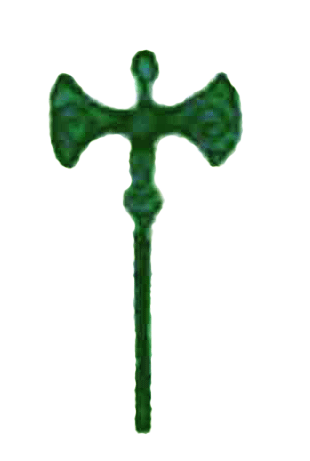
labrys,
études féministes/ estudos feministas
julho/ 2017- junho 2018 /juillet 2017-juin 2018
The self-portrait and alter ego of Hildegard Rosenthal, in São Paulo/Brazil, a dual approach in the dialogue with modern photography
Yara Schreiber Dines.
Abstract
In this article we analyze the specificity and meanings of photo essays from self-portraits and alter egos of Hildegard Rosenthal, a German artist who immigrated to São Paulo/Brazil, in the mid-1930s. The photographic series focuses on the presence of the female gender and its performance in the metropolis of São Paulo. The reflection provides an anthropological bias, seeks to contextualize this production in the imagery scenario at the time – in São Paulo and internationally -, analyze the characteristics and importance of the artist’s photographic production, comparing and opening a dialogue between her perspective and language of images with that of other artists of the period. These photographs can be found at the Moreira Salles Institute (São Paulo).
Key words: self-portrait, alter ego, female flâneurs, urban representation, anthropology of images, Hildegard Rosenthal.
Introduction
The set of self-portraits and alter egos[i] by Hildegard Rosenthal present a fertile imagery content illuminated and analyzed through anthropological reflection. In these essays, the characteristics of language and the expression of photography show unusual profiles of the artist’s personality, as well as of the visual[ii] culture of the period.
In this article, we will initially present and analyze the set of selected self-portraits of the artist followed by two series of alter egos produced by Hildegard. After the specific exhibition of the photographs, a reflection based on the reading, analysis and iconographic interpretation is carried out, mainly based on the anthropological and visual culture focus.
Hildegard Rosenthal was born in Zurich, Switzerland, in 1913, however, her parents were German. In her youth, she was already known to carry her photographic camera around, registering, with the influence of the New Vision, a boy in a descending axle rotation – Portrait of a boy (c. 1931), for which she earned a prize in the photography contest of the Neue Ferie Press[iii] (current Die Presse) newspaper. She learned her profession while still in Germany, beginning with a one and a half year photography course, with Paul Wolff (1877-1951), a pioneer in the use of the Leica. The photographer was one of the main ones to use the Leica. He was one of the mentors who used 35 mm photography; gave courses, illustrated publications, assembled exhibitions, and disseminated the technique and capacity of the miniature camera (Kossoy, 2007: 85).
According to author Richard Lionel, Berlim 1919-1933 (1993: 261,262), in photography from the beginning of the 20th century, some were tempted to do experimental photography, which needed the effort of invention and construction, a real play of shapes. László Moholy-Nagy[iv] (Bácsboród/Hungary, 1895, Chicago,1946) was a designer, photographer, painter and innovative design professor from the Bauhaus school, between 1923 and 1928. With his book Malerei Fotografia Filme (Painting, photography, cinema), from 1925, he appears to be a pioneer, formulating the aesthetics of the New Vision, in photography. This trend also used unusual forms of language such as photograms and photomontages that mixed photography with modern typography. The New Vision was ahead of the German photographic scene, becoming more prominent in 1929 with a series of grand exhibitions and publications that disseminated the movement.
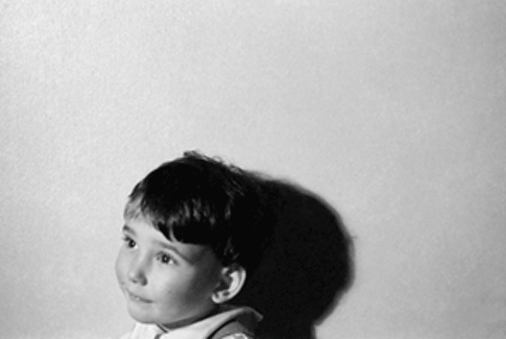
Hildegard Rosenthal, Portrait of a boy, Frankfurt, c. 1931, Moreira Salles Institute Collection
The photographer-professor influenced Hildegard’s production considerably, in the beginning, by encouraging the use of the 35 mm camera, which was her main professional companion in life and later, in the photography course done at the Gaendel Institute, also in Frankfurt, which lasted three years. Hildegard studied chemistry and practiced developing and enlarging images in the lab.
In the 1930s, photography was seen in Germany as an expression of modernity. In the initial decades of the 20th century, in that country, “photography was sponsored in the public as well as the private sphere, with the creation of a network of schools and courses, besides amateur photography clubs – that reached thousands all over Central Europe at the end of the 1920s – and whose huge production led to the emergence of specialized monthly magazines, as well as collective exhibits” (Falbel, 2009).
The vision of the photograph studied must also have been influenced by publications such as Berliner Illustriert Zeintun[v] and Munchner Illustrierte Presse[vi], at the forefront of the illustrated press, and mainly in photo reportage, as emphasized by Anat Falbel (2009).
The arrival of national-socialism in Germany provoked the migration of a considerable number of Jews. Walther Rosenthal, Hildegard Rosenthal’s boyfriend at the time, was Jewish, and he left his historical roots to search for a new place in distant lands.
In Germany, there was almost no information about the reality in Brazil of the 1930s[vii]. Many Jews who looked for tropical lands came by chance, i.e., lack of a better alternative – such as the United States and Argentina -, or because they already knew somebody living in the capitals.
Hans Rosenthal, Hildegard’s brother-in-law, was attracted by the land offer in Rolândia (PR), migrating with his parents to this city. Soon after, in 1936, came his brother Walther, and in the following year, Hildegard arrived in Santos to live with Walther, in São Paulo.
A first look at the work of Hildegard Rosenthal basically shows she was an emigrant or foreigner. Nonetheless, how would the arrival of this photographer in a new country in South America have been? What kind of view would be landing in the city, considering her education and influences acquired in Europe, based on modern references? How would she have dealt with her identity as a woman, photographer and emigrant, in her move to Brazil?
Settled in São Paulo, Hildegard initially went to work as the head of the Kosmos Fotos Lab, on Rua São Bento, in the center of the city. Soon after, she met Kurt Schendel (1896-1947)[viii] [ix], a German immigrant also recently arrived in Brazil who founded a news agency about Brazil for foreign countries called Press Information. She worked mainly as a photojournalist there between 1938 and 1947, for which she became better known.
It should be stressed that at the time, the presence of women in the Brazilian photographic production[x] was practically unseen, as an artistic and professional option. Therefore, knowing the specificity of this photographer’s look and her modern focus brings up the pioneering aspect of her work, at a time when São Paulo presented wide-ranging urban changes.
According to researchers Helouise Costa and Renato Rodrigues in the book A Modern Photography in Brazil: Analysis of Modern Experience (1995), the modern photography of São Paulo between 1940-1950 can be understood as an innovation process in photographic language, marked by radicalism in its form of expression, presenting new themes such as daily life objects. In modern photography, there is denial of the classic rules of composition – no centralization of the theme, rule of thirds and triangles (through this rule, the area to be photographed is divided into four triangles made up of two opposing and imaginary diagonal lines, each one, connecting two of the corners and meeting at a point in the center. The result of this intersection is right angles; the themes must be positioned in the intersections or on the lines) - the strong lines that characterize the theme are highlighted. There is also an intense trend towards geometrization of the subjects and suppression of the integrity of the traditional photographic process. A large part of these attributes is present in the photos selected and are analyzed in this article according to the edition shown.
I consider it stimulating to have found the series “self-portrait” and those I have called “alter ego”, when analyzing the set of images produced by Hildegard Rosenthal. This type of photography calls our attention because of its characteristics and for having been produced by women in the 1940s. These images raise specific questions related to the classical themes of photography, such as the portrait, the pose and staging, carrying out a dialogue with the real world or with fictional dimensions. This possibility of a dialogue brings the creation of the idea of flânerie[xi] closer, of the use of the public arena, the issues of gender and performance.
Development
Even if this fact is not remembered much in the history of western art, female artists[xii] created a great quantity of images of themselves. Frances Borzello, author of Seeing ourselves: women´s self-portraits (1998), raised more than 150 names of female artists who lived between the 16th century and the end of the 20th century (apud BOTTI, 2005:25)[xiii], and her work associating the respective stories of life and social framework, allows us to reveal and learn about self-image aspects of women in these societies, in different historical periods.
It is important to highlight that, in the history of art, in most of the cases, the female image was built through a male view, as men had the forms of production and circulation of art artefacts. Therefore, in general, women are present in artistic work as the object of the viewer and not as the subject that is looking. In the work presented here, we will analyze the imagery essays of a photographer who looks, stages and builds representations.
Based on the research carried out, it was determined that this work by the photographer, was not published as a complete series, in the magazines of the period nor in her exhibits in the 1970s and 1980s. They were brought up only in the Urban Scenes (1999) exhibit, in the catalogue under the same title, at the Moreira Salles Institute, and, more recently, in the catalogue Metrópole Hildegard Rosenthal (2009). However, they do not appear in any of the cases mentioned, as sets of images.
The non-disclosure of these photo essays, except more recently with the acquisition of the collection by the Moreira Salles Institute, raises questions such as: why didn’t the artist exhibit these photographic series in her exhibits in the 1980s? Why is it that even in the catalogues Urban scenes (1999) and Metropolis Hildegard Rosenthal (2009), the photos are not shown and highlighted as imagery narratives, when they are a series of self-portraits and alter egos of Hildegard Rosenthal? This article tries to understand and answer the inquiries, which refer to the personal universe of the artist and the culture of the time.
Both types of work – self-portraits and alter egos – exhibit fertile imagery content to be revealed and explored through reflection, as from a descriptive and analytical look and as photographic narratives. In these essays, the characteristics of the language and expression of the photograph bring up aspects that were ignored in that profile and character of Hildegard Rosenthal, such as the photographic culture of the period.
In the first set of images of self-portraits in closed environments, the photographer exhibits different facets of herself. While in the second photo essay, she emphasizes the path, route and use of the city center by a young woman – her alter ego –, circulating in the public area of the streets. Her way of dressing and trimmings infers the woman portrayed belongs to the middle class.
Let us now examine some aspects about the focus and use of the image by the field of anthropology[xiv]. Since this is a representation that requires critical reading and interpretation, the image is seen as primary information and an anthropological document.
It is important to highlight that, according to the anthropological view, “neither the photograph as an artefact, nor the interpretation of its object by the spectator, nor the understanding of the intention of the photographer can provide an holistic meaning to the images by themselves” (Scherer, 1996: 69). Only looking at all three as part of process, preferably, referring to a set of linked images, it is possible to obtain an important sociocultural meaning for the photos. The images constitute reliable evidence, which allows for reflection and interpretation, considered through an inter-relationship between the photographer, the object and the spectator.
The area of communication anthropology includes “the study of the photographer’s vision upon another person, and the perspective of the academic world on the photograph, besides the studies about the influence of the object on the image, as well as the analysis of the objects themselves. The study of construction of the other person by the spectator, and the use of images made by the audiences” (Scherer, 1996: 69).
The visual anthropology focus proposal is that of an analytical and critical study of the photograph, aiming at the contextualization of the images to help in the reconstruction of cultures. The methodology for the use of ethnographic photographs in anthropological research, according to anthropologist Joanna Scherer (1996), includes: a thorough study of internal evidence and the comparison of photographs with other images; the knowledge of the history of photography, with the technological limits of each period; the study of the photographer’s objectives and the way this language was used by the author; the reflection regarding the ethnographic objectives and a review of the historical evidence associated with the verification of the use already made by this means. As from the investigation of the use of the visual aspect in anthropology, explained above, we can work on the edition, reading, analysis and comparison of the images. Only by considering the standards of the topics studied, with a symbolic form and content can we use ethnographic and historical photographs as artefacts to think about cultures.
Self-portraits

1. Hildegard Rosenthal working with the amplifier, beside a coffee tray, c. 1942, Moreira Salles Institute Collection.
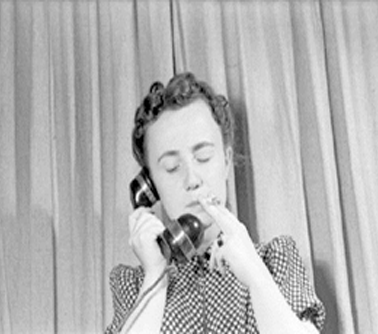
2. Hildegard Rosenthal on the telephone, c. 1940, Moreira Salles Institute Collection.
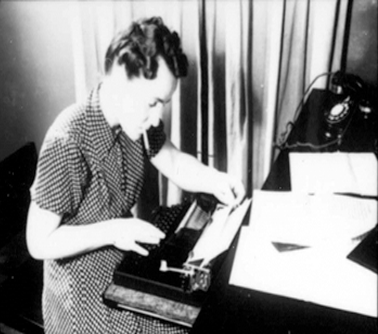
3. Hildegard Rosenthal with a typewriter, c. 1940, Moreira Salles Institute Collection.
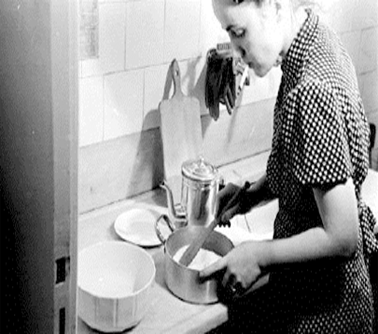
4. Hildegard Rosenthal in the kitchen, c. 1940, Moreira Salles Institute Collection.
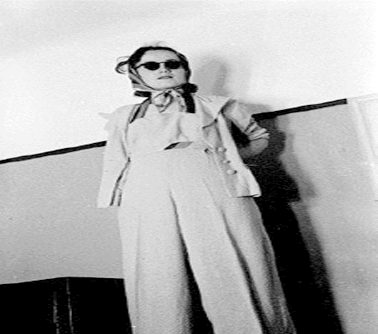
5. Untitled, 1940s, Moreira Salles Institute Collection.
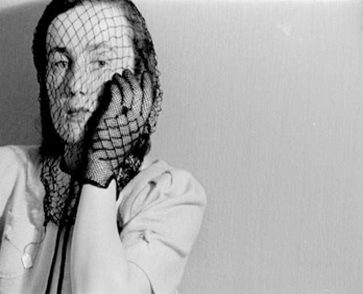
6. Hildegard Rosenthal with veil, c. 1940, Moreira Salles Institute Collection.
Another face of Hildegard Rosenthal in self-portraits
From the moment I feel I’m being watched by the photographic objective, everything changes: I begin to “pose”, I immediately transform myself into another body, I metamorphose myself into an image in advance. (BARTHES, 1984:22)
To better understand the self-portraits edited and exhibited above, we went in search of the author Roland Barthes, in The Light Chamber, that raises important reflections about portraits and poses, addressing the issue of imprecise and imaginary identity, for in his view “the photograph is the emergence of myself as another: a shrewd dissociation of the awareness of identity” (1984:28). For the author, the aspect of identity in the portrait is modified, as the individual, while he is himself, subtracted. Thus, there is a change in subjectiveness, with the presence of the self as another.
Regarding the comment made by Barthes, we notice that Hildegard Rosenthal exhibits an imprecise identity in her self-portraits, as she shows herself to be manifold, with several facts that combine and add to themselves, as seen in the different photos of the set when reading and interpreting them. According to Barthes, the pose softens the aspect of reality brought by the photograph when one searches for the best image of oneself. There is a simulacrum character, i.e., the individual becomes an idealization in a theater of appearances.
As from the understanding of pose in Barthes (1984), we conclude there is a certain similarity with which the photographer Hildegard Rosenthal performs her self-portrait essays, as she composes several poses, gestures and attitudes which, on the one hand, create the image of an independent, autonomous and professional woman, and, on the other, builds the profile of an elegant woman who pays attention to fashion, for example, when photographing herself with a hat and veil (image 6). Both representations complete each other and personify the photographer and are not different or contradictory.
Going deeper into the analysis of the pose in the portrait, it is also important to consider, what Annateresa Fabris remembered in this article ‘The pause in the pose; that the act of posing:
" [...] is the social idea registered in the sphere of the portrait, changing the likelihood, creating an ideal situation, where the person expresses herself though two historically determined codes – the “physiognomic” one, referring to the imaginative transformation of the actual body through the use of different artifices; the dress code, theorized by Honoré de Balzac, which addresses the apparatus provided by fashion and allows for radical denial of nudity, without it necessarily being biological." (2006:157).
The understanding Fabris has about the portrait becomes pertinent regarding the self-portraits being studied, as they show she was conscientious and knew the codes associated to portraits and self-portraits. For the author, both try to convey an idealized construction of likelihood and association to the social world.
Regarding the “physiognomic” aspect quoted by the author, the photographer’s self-portrait, registered in an ascending axle rotation (image 5), materializes an imaginary change in the body, as she stages herself to be taller than she actually is. In turn, in what refers to the dress code, Hildegard Rosenthal also shows she knows how to empower through the images she produces of herself, using gender and fashion tricks. In other words, the photographer seems to know how to deal with these two codes, using the subtle resources of culture and language to construct the staging and simulacrum of the different profiles she has.
Still about the pose, it is important to remember that it integrates a symbolic system of representation, just like the image that individuals create of themselves and of the reality to which they belong, as emphasized by sociologist Pierre Bourdieu, in La fotografia: un arte intermédio (1979).
The spontaneous search for straightforwardness, is understood here as objectification of society and is linked to hidden cultural values. According to Bourdieu, “in this society that glorifies the sense of honor, dignity and respectability, in this closed world in which the individual feels there is no escape at any time from the looks of others, one has to give others the most honorable and dignified image of oneself: a prim and rigid pose, where ‘right, you can point at me’ seems to be an expression of this unconscious intention and constitutes the limit of the constructed image” (1979:130)[xv] [xvi].
In this perspective, Bourdieu questions: “In these conditions, how can the representation of society be anything else and not a society in representation?” (1979: 130). A vigorous inquiry that makes us think about the incorporation of social rules in the portrayal of the study, in the poses and facial expression. Constructions by Hildegard Rosenthal in her self-portraits.
The rich considerations made by Barthes (1984), Fabris (2006) and Bourdieu (1979) helped to leverage the analysis of the photo essays by Hildegard Rosenthal. Even though they provide different theoretical approaches they still maintain a dialogue and complement each other, as they present paths pertaining to the reflection about the narratives of the three self-portraits we will present below: with the amplifier (image 1, at home (image 2, 3, 4) and with the veil (image 6).
* * *
In the picture Hildegard Rosenthal working with the amplifier, beside a coffee tray, c. 1942, we see the author in her lab, in front of the equipment. In other words, the artist comes across the result of her work with the apparatus – the developed picture. It is a scene from her daily life, reinforced by the presence of the coffee pot, beside the amplifier.
The photo shows a metalanguage[xvii] when showing the self-portrait of the photographer in the agency, appreciating the product of her work – developing the image. This developed photo also appears as a mirror, since we see the creator and her work. The registration of the photographer in a photographic act was not common at that time in São Paulo, which potentializes the value of the work of Hildegard Rosenthal.
We then observe three images forming a set – Hildegard Rosenthal on the telephone, Hildegard Rosenthal in the kitchen and Hildegard Rosenthal with the typewriter (images 2, 3 e 4) produced around the 1940s. In this series, the focus of the scene, which is the photographer in action, is highlighted.
In Hildegard Rosenthal on the telephone we see a classical representation of a portrait, with the photographer present in the center of the image, in the foreground, and the curtains behind forming a scenario. The register builds the scene of Hildegard concerned about showing herself as a professional.
The photographer appears alone and smoking, in all three representations. It is interesting to observe Hildegard’s arms and hands, as well as her untidy hair in this set of photos. Her whole being is moving and fulfilling some activity – talking on the phone, cooking, typewriting. We can thus surmise the construction of the self-portrait of a woman concentrated in herself and in work, appearing as a character of herself, independent, disclosing her work and organizing her daily life.
The set also points out the fact that Hildegard photographed herself working and cooking at home, without establishing a hierarchy between the activities performed in the domestic sphere. On the contrary, the artist builds scenes showing that her professional work was as important as the household activities.
Paula Scarpin Gonçalves, in Valley of the Roses – Hildegard Rosenthal – pioneer of photojournalism in Brazil (2007), introduces an interesting comment about how Hildegard Rosenthal combined her personal life with her professional activity:
“[...] I get annoyed when I meet people who become startled when I say I am not working any longer. They don’t seem to understand that there are human experiences that are as important as the artistic activity” (2007:101).
It is important to highlight that in this series of pictures – a narrative built as a representation – we see a woman in her professional work environment and in the domestic environment, however, there is no indication that emphasizes the fact that she is a photographer. As we know beforehand that we are handling self-portraits of a photographer in her home, we can understand that the woman represented is the artist in her private space. Thus, on the one hand, we highlight the relevance of the caption in this narrative series, as the written word indicates the apparent and connotative content of the images. On the other hand, in the construction of the series of self-portraits at home, she appears in a simple but beautiful dress, to be seen as a woman, composing the imagination of professional, modern and practical women.
Regarding the series of self-portraits, Renata Rosenthal, granddaughter of Hildegard Rosenthal, comments in her testimonial (02/2014)[xviii]: “[...] granny smoking? I had never seen my Granny with a cigarette in her mouth [...]”. Thus, the detail of the cigarette present in the three self-portraits at home is a relevant prop, as it composes the image that represents modern women at the time, according to the photographer’s imagination.
Since this essay did not become public while the photographer was still alive[xix] , it was not possible to know if it was produced through Hildegard’s own will and initiative or if it was a request for publication in some magazine of the period, however, for some reason, was never published. Supposing that the essay was not made due to an external demand, we can infer that Hildegard Rosenthal wanted to do the staging to register a certain image of herself. In other words, it is the construction of a narrative and visual memory of a young professional in her time. As previously mentioned, we can infer that the series of self-portraits by Hildegard Rosenthal at home is a metalanguage where she produces a fine, witty and polished representation of herself.
In the photo Untitled (image 5), we see a self-portrait of Hildegard registered with an ascending axle rotation framework, as the photographer wanted to appear tall, when in fact she was short. The photo was registered inside a building, with the model appearing as if she were ready to go out and reveal a certain European air – when composing the image with the scarf on her head and glasses for protection against the wind and sun –, highlighting her origins.
Regarding the image Hildegard Rosenthal with a veil (image 6), which only carries this denomination, it is important to point out that Hildegard’s self-portrait is concentrated in the left corner of the photo occupying the left half of the rectangle, which conveys the idea of proximity. Furthermore, the photographer builds the image of a modern, elegant woman who likes fashion and has subtle airs.
If in the series of self-portraits at home, it was possible to know an important facet of her personality and the way Hildegard acted professionally, in the self-portrait with the veil, she shows another profile: her elegant side. We can see that the photographer paid attention to fashion and knew the visual culture from women’s magazines. She appropriates this culture in her way, when creating the scene and pose in the photo.
Reinforcing this idea, Renata Rosenthal says in her testimonial that her grandmother Hildegard, in her daily life, was different from the representation built in the self-portrait with a veil. We can conclude that it was actually the conception of the image of a fashionable woman.
Renata says:
"[...] She was very simple, so she didn’t want to go like that, when it was her exhibit. When it was someone else’s exhibit, she was the first person to arrive. She loved going to a vernissage, seeing people, talking. However, about herself, she would say, I’m not going [...] I don’t have anything to wear [...], she was not vain, didn’t wear make-up or do her hair and nails, my grandmother wasn’t like that [...]."(02/2014).
From this excerpt taken from a testimonial, we can note the importance of orality and the testimonial as a source of knowledge construction. When comparing the set studied here, with the testimonial of Hildegard’s granddaughter, the meaning of these images was discovered. This helped us to know the photographer’s profile better. i.e., we can state that the photo essay of self-portraits establishes a dialogue with the images Untitled and Hildegard with a veil, showing different facets, the photographer wanted to build and expose.
In the last two self-portraits by Hildegard, we mainly see the construction of an elegant, well-informed and updated figure regarding women’s fashion – characteristics symbolized by the use of fashion accessories that provide the model with a certain charm. Her granddaughter, Renata, reasserts her grandmother’s wish to present herself with elegance in social life, even if in her daily life she cultivated another side of herself. This simpler more unambitious side of the artist does not appear in the photos analyzed here.
Renata Rosenthal says:
[...] she was a very humble and simple person. She liked simple people [...] I think that for my grandmother the very sophisticated was aggressive in some manner, maybe because she had been through two wars [...][xx] (02/2014).
Still regarding the self-portraits by Hildegard Rosenthal, Untitled and Hildegard Rosenthal with veil, and their connection with modern photography in São Paulo at the beginning of the 1940s, it is possible to compare these images to the self-portraits by Geraldo de Barros, in the series Fotoformas, from the end of the 1940s.
Fotoformas by Geraldo de Barros is a set of photographs produced between the end of the 1940s and the beginning of the 1950s. The series of photos presents diversity in their typology. There are images linked to Constructivism; to the language of Expressionism within the international artistic context of the post-war period; to the New Vision trend in photography, among other artistic movements of the period. (ESPADA: 2006, 3).
Researcher Heloísa Espada (2006) in her master’s thesis located seventeen self-portraits registered by Barros, between 1947 and 1951. This important photographer, painter and designer integrated Foto Cine Clube Bandeirantes, performing many technical and artistic experiences during the era of modern photography in São Paulo. In some of his self-portraits he shows an ironic look, showing signs that he is representing and creating characters.
The self-portraits by Geraldo de Barros, even if they present his face in a very clear manner, expose the elaboration of fictional scenes, created through the posture of the artist before the camera. In the image shown below, we notice the previous construction of the photographic moment, as the light, the clothing, the framing of the face and his expression are determined and precise.
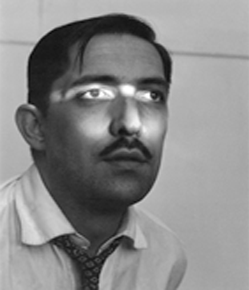
Geraldo de Barros, Self-portrait, Moreira Salles Institute, 1949.
For Heloísa Espada:
[...] self-portrait (IMS) from 1949 refers to the posture of Barros in the photo. The straight line over the eyes and the very diffuse light focus on the face create a geometrical mask that can be read as a reference to the geometry of Fotoformas. Here, he represents the role of the modern artist (and the photographer), who must reveal new forms of seeing and feeling. (2006:65).
A common aspect in self-portraits by Hildegard Rosenthal and Geraldo de Barros is the fact that the photo emerged as a construction and staging area. Furthermore, both photographers used technical support to create and forge the desired image of themselves, according to the modern photography criteria at the time.
Resuming the self-portrait of Hildegard Rosenthal with the veil it is still stimulating to comment on it under the perspective of similar images in modern photography abroad, at this same time. The photographer Walker Evans, from the United States, portrayed two women in the subway using a hat with a veil; the Austrian who settled in the United States, Lisette Model, also photographed women with the ornament in a fashion show and on the street, in the second half of the 1940s.
According to Baudot (2008: 114), hats with veils, which partially hide the face and/or the eyes, were very elegant, and became popular during the 1940s. During the period of French occupation, Pauline Adam, who founded Maison Paulette-Mode in 1929, developed voilettes (veils used in hats). She, together with Claude Saint-Cyr, represent the last generation of great milliners. We notice that the voilettes fashion spread to many places, Beyond Europe, also arriving in Brazil, which adopted French fashion references at the time.
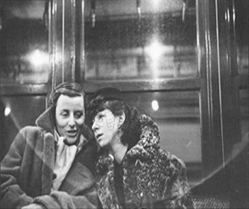
Walker Evans, Many are Called, 1938-1941.
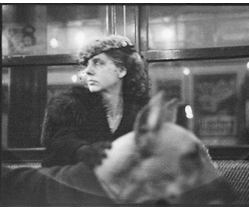
Walker Evans, Many are Called, 1938-1941.
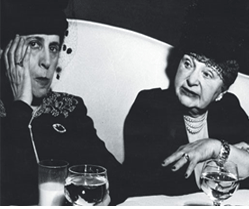
Lisette Model, Fashion Show, Hotel Pierre, NYC, c. 1946.
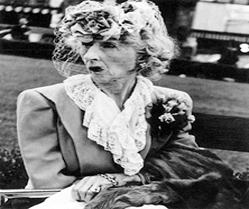
Lisette Model, Woman with veil, San Francisco 1949.
Self-portrait and modern photography
In relation to self-portraits and the history of photography, it is noteworthy that the production of portraits in series is a characteristic of modern photography. Futurism, Bauhaus and Constructivism rendered this language sequential. Moholy Nagy e Rodchenko[xxi] [1] introduced the idea of a sequence of portraits, to cover the multiplicity of a being in its different facets (ARAUJO, 2003).
Barthes, Baudrillard and Schaeffer, in their texts, already elaborated the idea that the photographic camera makes the staging complex, producing fictionalization of reality for handling the sign of the absent subject (Araujo, 2003). It is essential to point out that this idea of photography had already been present since the end of the 19th century. In other words, these authors understand that photography is a representation as it is a double cutout of what is real and always according to the perspective of the photographer. Therefore, it also has a fictional character. In this sense, we can understand that the series of self-portraits by Hildegard Rosenthal, accomplished in the period of modern photography, is close to the idea of fictionalization.
Resuming Barthes (1984), specifically regarding his perspective of portraits in photography. The author considers the presence of a dimension of inauthenticity, where the portrayed figure brings with it a burden of simulacrum, which brings it closer to a self-portrait. The portrait and the self-portrait try to build the best image of oneself, i.e., there is a shift towards fiction.
In relation to self-portraits by Hildegard Rosenthal, as previously mentioned, we believe the photographer, in the making of a self, intended to be seen as a professional as well as an elegant and charming woman – differential and complementary profiles of the same person.
Paraphrasing Annateresa Fabris, the identity of a self-portrait is built based on well-defined social standards, which support the elaboration of “a precarious and fictional self – even in its more standard uses –, which allows us to establish a continuum between the 19th and the 20th century” (Fabris: 2004:55).
In the perspective of the feminist Whitney Chadwick, an art historian, a self-portrait problematizes the relation between subject and object simultaneously touching on two issues: female artists have the possibility of considering self-images elaborated throughout the story, taking over control of these representations, and at the same time, they have a way of asserting themselves as artists, a field that was considered male for a very long time.
Every woman who paints a self-portrait, sculpts likelihood, or places herself in front of the camera lens where she controls the obturator and, in some manner, challenges the complex relation between male action and female passiveness in the history of western art (apud BOTTI, 2005:43).
The unique aspect about the set of self-portraits by Hildegard Rosenthal is they were never published while she was still alive, as already mentioned in this article. Thus, the reason for not publishing at the Exhibitions she participated in during the 1970s and 1980s remains unanswered. One possible answer is that maybe Hildegard only wanted to show herself as a photojournalist and documentary photographer – her professional practice –, keeping to herself her more experimental and fictional aspect.
Still with respect to self-portraits as the unfolding of the identity, Fabris quotes a rich excerpt from Sherlock Holmes about the potential of a photographic portrait to convey data about a person, which would be difficult to capture through the actual face:
Sometimes, looking at a portrait, it seems we only view the face we know, always the same as itself. However, another look shows us a completely different aspect, even if completely recognizable. After a third look, and even a fourth one, we are convinced that our friend is not one, but many, regarding appearance and mental and emotional attitudes whereby her intimate nature is presented before us (2004:53).
As they bring up the images that female artists want to expose themselves, self-portraits show a symbolic dimension, and reveal characteristics of a social culture marked by gender relations that distinguish different social ‘loci’ for men and women.
In this respect, according to visual researchers, Marion Beckers and Elisabeth Moortgat,(2016: 173) “dans tout autoportrait ou presque, on peut trouver dês élements d´interrogation et d´affirmation de soi, une contradiction existentielle à laquelle l´être se heurte sous léffet du doute et qui est inhérente à toute activite artistique.”[xxii]
We therefore understand that, when creating a series of self-portraits, Hildegard Rosenthal exposes different and unique faces, which dialogue between them and complement each other, revealing several personas of herself. These unknown facets of the artist in her daily life, which are built as self-portraits elaborated based on the image they intended to convey and establish - real as well as fictional -, as an independent and professional woman, but also, attractive and mysterious. The image she creates of herself, current and modern, broad and multifaceted, can be detected upon contemplation of the set of self-portraits exposed and analyzed in this article with a watchful eye.
Alter ego[xxiii] Series
I
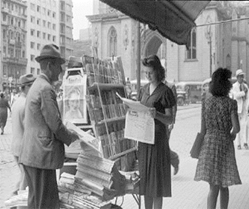
1. Newsstand, c. 1942, Moreira Salles Institute Collection.
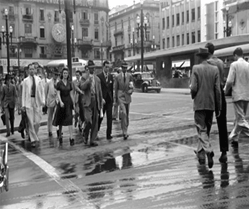
2. Praça do Patriarca, 1940, Moreira Salles Institute Collection.
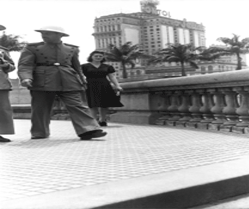
3. Untitled, 1940, Moreira Salles Institute Collection.
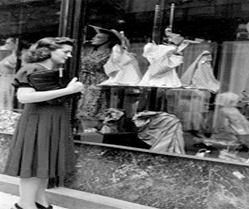
4. Untitled, 1940, Moreira Salles Institute Collection.
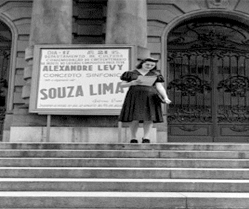
5. Untitled, 1940, Moreira Salles Institute Collection.
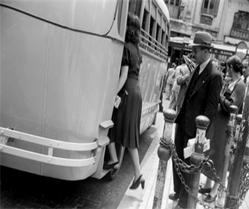
6. Untitled, 1940, Moreira Salles Institute Collection.
II
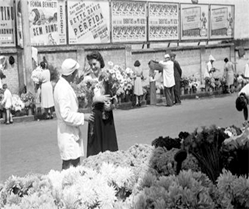
1.Untitled, 1940, Moreira Salles Institute Collection.
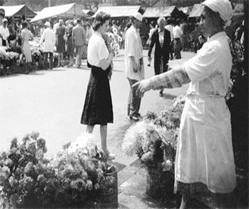
2.Untitled, 1940, Moreira Salles Institute Collection.
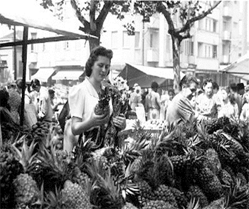
3. Untitled, 1940, Moreira Salles Institute Collection.
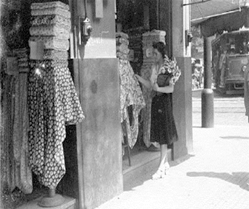
4. Untitled, 1940, Moreira Salles Institute Collection.
The alter ego series occurs on the street, covering the new and old center of São Paulo, in the 1940s. i.e., different from the series of self-portraits – made in the private area of her home —, those of alter egos have a female gender flânerie, in the public arena. The impression conveyed by the photos is that Hildegard invited a friend[xxiv] to participate in the record, as the personification of a younger woman walking downtown, because to carry out an agenda and control the photographic process, it was necessary to have an alter ego. In the series, we noted that the young girl, in her path and route around the city is the focus of the staging and narratives. She (the alter ego) is posing and following an agenda, although the images convey the impression of “naturalness”.
We were not able to discover the name of Hildegard’s friend, even after checking the testimonials of her daughter, Dorothéa Rosenthal, and her granddaughter, Renata Rosenthal, which would have been stimulating for the research, in the sense of knowing what motivated the photographer to make her photo essay. When I talked to Rosa Esteves (22/12/2014), a museologist and plastic artist, a friend of Hildegard Rosenthal, she suggested the possibility of this essay having been made for the photographer to show instantaneous work produced on the street, with the intention of gathering material to be presented in magazines, however, this is only a possibility.
David William Foster, in the article “Downtown in São Paulo with Hildegard Rosenthal´s camera” (2005), is the only author that, on studying images of the female photographer, raises the idea of her being a feminist. The hypothesis of the author is based on observation and the analysis that her pictures constantly show male figures. Under this perspective, Hildegard Rosenthal would be, on the one hand, emphasizing the male presence in the occupation of the area on the street in downtown São Paulo, as a worker, pedestrian or urban character; on the other hand, showing the poor visibility of the female figure.
Given the study by Foster and agreeing with Rosa Esteves, we suggested the possibility of Hildegard Rosenthal having made two photo essays with the staging of female alter egos, to have instantaneous work on the use of the center of São Paulo by the young female figure and with the intention of calling attention to the presence of the gender in the central region, considering its uses, paths, and forms of occupation.
In the first alter ego essay, and based on my photographic edition, the young girl is wearing a dark dress and carrying a folder as if she were circling around the city center, for work (image 1). Her route begins in Praça de Sé, where we see her looking at a newspaper in the newsstand and being observed by the salesman. She then appears in Praça do Patriarca, crossing the street in the direction of Viaduto do Chá and surrounded by male figures (image 2). The framework of the photographic registry makes it clear that the figure of the young woman by herself is highlighted compared to the men, conveying the idea of freedom and autonomy.
In the sequence, in the photo with an ascending rotation (image 3), she appears walking on Viaduto do Chá. She can be seen at the back of Edifício Martinelli, which confers to the scene the aspect of modernity with the strength and height of this building, a symbol of the metropolis. Next, the young girl is in front of the Municipal Theater glancing through a folder (image 4), showing her interest in music and culture. In the penultimate photo of this set of images, the young girl looks at the window of a store that sells scarves (image 5) and, closing the series, we see her from behind, climbing into the bus (image 6). The lower part of her legs is highlighted in the scene and a man accompanies her movements with his eyes.
In the second alter ego photo essay, Hildegard’s friend is using a white shirt, dark skirt, and the photographic record also occurs during the day. We conclude that the essay begins in a street market, at the flower stand. She chooses a bouquet of daisies (image 1), which will remain with her during the whole sequence of images. Hildegard’s alter ego then continues with the flowers to Praça da República, stopping at the fruit stand – more specifically, with pineapples -, sign of tropicality (image 3). Finally, the young girl is photographed at the door of a fabric store appreciating them (image 4).
Considering the captions of both series, the researchers of the Moreira Salles Institute pointed out only in a few of them the place and/or figure of the professional present in the image (as occurs, for example, with image 2, in Praça do Patriarca), inserting Untitled in most of the captions.
Gisele Freund (1986) considers that the portrait and self-portrait address the issue of identity of the artist. In this perspective, we can understand that the photo essays of Rosenthal’s alter egos also discuss her identity and that of her double; appearing in this manner to the external eye. The author also sees the self-portrait genre as the dramatization of social identity, which can be extended to the creation of the alter egos in the series by Hildegard Rosenthal. We see their use and construction with staging in the public arena of downtown São Paulo, a region of the social and economically vibrant city at the time.
In other words, the artist prepares two photographic agendas to be staged in this region, creating the alter ego. Her intention of making it possible to register the imagery essay where she tries to show her double, while integrating the female gender, circulating in this area that she appreciated very much, according to the testimonial of her granddaughter, Renata Rosenthal. It is interesting to note that probably, Hildegard Rosenthal had the intention of forging the figure of a young woman walking around the central area of the metropolis, but without the representation of a freelance photographer, such as she was, for the scenes portrayed do not show us signs pointing to this direction.
In this sense, when creating a photo essay with a unique and very particular character for the time, the photographer not only registers a document of her life, but also produces a scene where her double represents aspects of the daily life of a young, independent, middle-class woman – inferred by her clothing –, conveying an image of freedom, trust, autonomy and tranquility in the path covered, in an environment still dominated by males, i.e., showing her empowerment as a photographer and that of her double, her alter ego.
It is important to highlight that we did not find another alter ego essay in the work of modern photographers in São Paulo, in the same period. Thus, in trying to understand possible artistic influences in the making of this series, we made a comparison of this photographic genre with that of other artists, at the time she studied photography in Germany, trying to see resonances in the visual culture of that country in her work. We researched the images in the work of Bauhaus photographers and artists and from the United States. As from research initiated on modern Bauhaus artists – such as Germaine Krull, Gertrud Arndt, Florence Henri and Ilse Bing –, and from the United States – such as Berenice Abbott and Helen Levitt –, it was found that none of these artists made essays with alter egos. In the beginning of the 20th century, more specifically in c. 1921, Marcel Duchamp, photographed by Man Ray, is the artist that creates an alter ego called Rrose Selavy[xxv]. This name consists of a play on words “Eros, c´est la vie”, “Eros, that is life” or “arroser la vie”, among others. The figure of this alter ego by Marcel Duchamp represented a daring aspect of his ideas and work, developed throughout his life. The creation of Marcel Duchamp’s alter ego was introduced in this text as it integrates aspects from the visual culture of the 1920s.
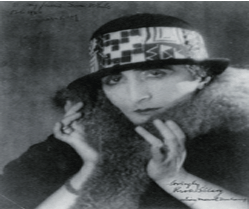
Man Ray, Marcel Duchamp as Rrose Selavy, c 1921
It is inspiring to note that the photo essay of the artist’s alter ego is a modern expression of language and connected to its time but provides a dialogue with the idea of flânerie and performance. We will now see how the series of alter egos by Hildegard Rosental come close to these ideas.
Hildegard Rosenthal and her alter ego: public arena, gender and performance on the streets in downtown São Paulo
After the first comments about the alter ego photos by Hildegard Rosenthal, we will now unravel this idea conceptually, which in this article unfolds itself into issues associated to the public arena, gender and the practice of performance, in the mid-20th century. To carry out this reflection, we cover authors such as Annateresa Fabris, Margareth Rago and Richard Schechner, who, from specific and complementary points of view allow for a rich analysis of the intermingling of ideas present in the photo essay of the alter ego.
Regarding the issue of similarity in the alter ego, Annateresa Fabris (2006:58), commenting on the photographic portrait, addresses the idea of similarity in this type of image. Analyzing the characteristics of the portrait, the author calls attention to the idea of identity and dimension of the pose as a defining aspect not only an aesthetic one, the idea of identity itself and a moral reference. This idea can also be applied to the alter ego.
In the case of Fabris, the pose integrates and constitutes a symbolic system where there is a compositional part that includes body language and the clothing worn. If in a first phase the pose solves technical issues about the construction of the identity, in parallel, it presents the dimension of a simulacrum.
Through the pose, the individual becomes a model and is registered as an appearance among many others, acting in a scenario that provides her with a discursive, or even fictitious identity. This act is the result of a simultaneous visual and social elaboration.
We can therefore view the photo essays of Hildegard Rosenthal’s alter egos as a dynamic of mirrors and “appearances of others”, built in the streets of the center of São Paulo. The image of a woman is created, not as a person, but as a social mask of a young individual, going to the city center and following a path and route according to the story that was imagined.
Through the creation of the alter ego, the female photographer provokes a discussion about the female identity issue regarding her acts, conduct and behavior when close to a male figure in the metropolis of São Paulo, in the mid-20th century.
The reflection provoked by the alter ego series presents a relevance in the studies about gender and the city and gender and the public arena, as, still at the time, the main environment for middle class women and those of the elite was at home, i.e., restricted to the private life sphere. Women who belonged to underprivileged classes, circulated around factories and work on the streets.
In the 1940s, even though the women from grassroots classes worked as secretaries, switchboard operators, telegraph operators, teachers, nurses, seamstresses, among other trades, and were recognized as professionals, the current morality would continue to highlight the relevance of women when carrying out their work at home, with their children and husband. This was considered their main mission[xxvi]. Nevertheless, all women needed to overcome several barriers to participate in the labor universe, regardless of the social class they belonged to.
Also, according to Margareth Rago, “from the variation in wages to physical intimidation, from intellectual disqualification to sexual harassment, they always had to fight against countless obstacles to enter a field defined – by men – as being ‘naturally male’” [xxvii].
Despite the modernized behavior, for men and women in urban social life to reflect upon the discourse of different social sectors, what calls our attention is the threat towards female honor built by the labor universe. English and French economists, as well as doctors and hygienists, communicated that the occupations performed by women outside their homes ruined the family. Without the permanent care of Mothers, family ties remained loose and when they left their homes to work, these women would not be dedicated Mothers and would not value marriage and maternity.
Even though the reasons that led Hildegard Rosenthal to make photo essays using a friend to represent her alter egos are unknown – and even though she sometimes made these records motivated by the need to have images about this topic to publish in magazines -, when producing these essays, the photographer emphasizes the presence of women in the urban environment. When enabling and highlighting the figure of women on the street, their paths and routes, she removes them from their almost invisible condition, given the predominance at the time, of the male workers who occupied this territory during the day and even at night.
The alter ego essays by Hildegard Rosenthal create photographic series or narratives of portraits, one of the constituent aspects of modern photography. When narrating a story using different images, the photographer provides a new meaning for it through real and fictitious data that in some way interact with the imagination of those who see and capture the story.
Moreover, the photo essays of the alter egos registered by Hildegard Rosenthal enhance the idea of a portrait as a representation and, in a broader sense, we can also understand that it creates a simulacrum which, according to Fabris (2004: 66) would be “an artifice in which the cultural order is inscribed as a montage, i.e., a second epidermis, made up of images from different backgrounds”, or origins, even different times.
In the case of the alter egos by Hildegard Rosenthal, the montage is made considering the construction of the female figure, young, seemingly well-educated, decisive, and who circulated autonomously through scenarios featured in the central area of the metropolis in the mid-20th century. This artifice is also elaborated by the creation of two specific narratives, which complement each other.
In these series, the fact that the photographer conceives the topic of the essay, inviting a friend to go together, performing flânerie in the city center, registering her paths and elaborating a narrative, allows her to act in pre-production and the production of images. Thus, she creates the staging and simulacrum conceived with a woman’s own eyes, putting in an appearance and the belonging of the female gender to the social life of the metropolis.
We notice how the work of Hildegard Rosenthal from the 1940s is fertile. The artist not only shows that she dominates the language of modern photography, but also creates artefacts and narratives with a gender bias, drawing on her visual culture and European education.
According to Richard Schechner, a professor of performance studies from the Tisch School of the Arts at the New York University, we can understand that these manifestations “mark identities, double the time, reshape and adorn the body, and tell stories. Art performances, rituals or everyday life activities – are ‘restored behaviors,’ ‘behaviors experienced twice’, actions carried out for which people practice and rehearse” (2006, s.p.).
As from this comprehension of performance, we can understand the photo essays of Hildegard Rosenthal’s alter egos in an analysis, also as the execution of a manifestation of this type, seeing her with a current perspective. The female photographer was not aware of this idea in the 1940s, as a form of expression. However, when registering the flâneries of their alter egos around the streets of São Paulo in the 1940s, she registered the images and built her narrative, but also created this manifestation. According to the focus given by Richard Schechner, even if she was Hildegard’s friend who had experienced these actions, this is also considered a performance.
*
* *
Closing remarks
Resuming the characteristics of the photographer’s series of self-portraits that were previously analyzed, we highlight her differential aspect regarding the language of imagery in modern photography produced in São Paulo, at the time. We emphasize the fictional and experimental profile of Hildegard Rosenthal, hidden by the figure of the photojournalist and the documentary photographer, however, brought to the current time, which allows for the creation of another perspective of her production. Thus, we incorporate the relevant and riveting face of the photographer.
It is important to emphasize that the series of alter egos was made in the city center, on the street, in the beginning of the 1940s, when the image of women in the public arena was almost invisible, which can be seen when comparing her work with that of other photographers from that era. Therefore, we notice that the series exhibits the audacity of Hildegard Rosenthal’s photographic agency when she highlights the presence of women in the central area of the metropolis, circulating and enjoying it.
Although some women already worked outside the home at the time, and were considered modern, their visual representation in photos of the public environment was not constant. Hildegard Rosenthal, who had lived in Frankfurt and Paris and experienced the occupation of these metropolis by women, sheds light on women, through the alter ego, highlighting specific forms of urban practice of the female gender in São Paulo.
In these series, photographs in the public arena made by a female artist[xxviii] are emphasized, a novelty for Brazil at the time, as in the previous decade, the few existing female photographers worked in their own closed studios or in those of their husbands, i.e., within the dimension associated to home.
The reflection about the photo essays of Hildegard’s alter egos emphasizes the unique characteristics of the latter at the time they were produced, which allows for the creation of fertile discussion between image and gender; image, gender and modern photography; and image and performance. These photographic narratives by Hildegard Rosenthal, therefore, unfold and encourage current reflection in different areas of research as we try to show with this article.
Bibliography
ARAÚJO, Virginia Gil. 2003. O Auto-retrato fotográfico: um estudo sobre a construção fisionômica como arbitrariedade em Artur Barrio. São Paulo. Disponível em https://webhp?sourceid=chrome-instant&ion=1&espv=2&ie=UTF-8#q=virginia%20gil%20araujo%20o%20auto-retratofotografico . Consultado em 16/07/2014, 10 e 11/2014.
BARBON, Lilian Patricia. 2012. O Autorretrato fotográfico na arte contemporânea. Florianópolis: Dissertação de Mestrado, Universidade do Estado de Santa Catarina - UDESC, Centro de Artes – CEART.
BARBOSA, Andréa e CUNHA, Edgar Teodoro da. 2006. Antropologia e Imagem. Rio de
Janeiro: Jorge Zahar Editor.
BARBOSA, Andréa, CUNHA, Edgar Teodoro da, HIKIJI, Rose Satiko Gitirana. 2009. Imagem-Conhecimento. Antropologia, cinema e outros diálogos. Campinas: Papirus Editora.
BAUDOT, François. 2008. Moda do século. São Paulo: Cosac Naify.
BARTHES, Roland. 1984. A Câmara Clara. Lisboa: Edições 70.
BECKERS, Marion, MOORTGAT, Elisabeth. 2016. Autoportrait, mise em scène de soi et identité sexuelle – femmes photographes entre 1850 et 1945. Qui a peur des Femmes Photographes? (1839-1945). Paris: Catalogue, Museé de Orsay, Museé de L´Orangerie.
BORZELLO, Frances. 2016. Seeing Ourselves Women´s Self Portraits. London: Thames & Hudson.
BOTTI, Mariana Meloni Vieira. 2005. Espelho, espelho meu? Auto-retratos fotográficos de artistas brasileiras na contemporaneidade. Campinas: Instituto de Artes, Dissertação de Mestrado.
BOURDIEU, Pierre e Bourdieu, Marie Claire. 2006. O Camponês e a Fotografia. Revista de Sociologia Política. Curitiba: 26, p. 31-39, jun.
CALLAN, Georgina O´ Hara. 2007. Enciclopédia da moda: de 1840 a década de 80. São Paulo: Companhia das Letras.
CARDONI, Vera Regina Santos. 2003. A Estética da Transitoriedade Arthur Schnitzler e Sigmund Freud. Porto Alegre: Dissertação de Mestrado, UFRGS.
CHIARELLI, Tadeu. 1999. A fotografia contaminada. Arte internacional brasileira. São Paulo: Lemos, pp.115-120.
COSTA, Helouíse. Escola Paulista de Fotografia - uma vanguarda possível? http://www.iar.unicamp.br/dap/vanguarda/artigos_pdf/helouise_costa.pdf , Consultado em 09/02/2015.
DINES, Yara Schreiber. 2017. São Paulo na imagética de Hildegard Rosenthal e de Alice Brill. São Paulo: Proa Revista Antropologia e Arte.
DUBY, Georges, Perrot Michelle (org). 1999. História das Mulheres. Porto: Afrontamento, vol. 1 a 5.
ESPADA, Heloísa. 2006. Fotoformas: a máquina lúdica de Geraldo de Barros. São Paulo: Dissertação de Mestrado, Escola de Comunicação e Artes/Universidade de São Paulo.
FABRIS, Annateresa. 2006. A pose pausada. A Fotografia e seus arredores. Santa Catarina: Universidade Federal de Santa Catarina, p. 157-161.
_________________. 2004. Identidades Virtuais. Uma Leitura do Retrato Fotográfico. Minas Gerais: UFMG.
FALBEL, Anat. Peter Scheier. 2009. Fotografia e paisagem urbana no Novo Mundo. São Paulo: Boletim Grupo de Estudos Arte & Fotografia 3, Departamento de Artes Plásticas da Escola de Comunicação e Artes da Universidade de São Paulo, maio.
FOSTER, David William. 2005. Dowtown in São Paulo with Hildegard Rosenthal´s camera. Curitiba: Revista Tecnologia e Sociedade. N. 1.
GELL, Alfred. 1998. Art and agency: an anthropological theory. Oxford: Oxford University Press.
FREUND, Gisele. 1996. La fotografia como documento social. Barcelona: Gustavo Gili.
GONÇALVES, Paula Chrystina Scarpin. 2007. Vale das Rosas - Hildegard Rosenthal - pioneira da fotografia do Brasil. São Paulo: Trabalho de Conclusão de Curso, Escola de Comunicação e Artes / Universidade de São Paulo.
GEERTZ, Clifford. 2001. Nova Luz sobre a Antropologia. Rio de Janeiro: Jorge Zahar Editores.
GEERTZ, Clifford. 1997. A arte como um sistema cultural. O Saber local. Novos ensaios em antropologia interpretativa.
JUNIOR, Rubens Fernandes. 2006. Processo de Criação na Fotografia - apontamentos para o entendimento dos vetores e das variáveis da produção fotográfica. São Paulo: FACOM, n. 16, 2º semestre.
KOTHE, Flávio R. 1985. O flâneur. Walter Benjamin. São Paulo: Editora Ática.
KOSSOY, Boris. 2007. A Fotorreportagem no Brasil: O Pioneirismo de Hildegard Rosenthal. Os Tempos da Fotografia - o efêmero e o perpétuo. São Paulo: Ateliê Editorial, 2ª edição.
LÉVIS-STRAUSS, Claude. 1997. Olhar, Escutar, Ler. São Paulo: Companhia das Letras.
LIONEL, Richard. 1993. Berlim 1919-1933. Rio de Janeiro: Editora Zahar.
MARIANO, Silvana Aparecida. 2005. O sujeito do feminismo e o pós-estruturalismo. Estudos Feministas. Florianópolis: 13(3): 320, set.-dez.
MARTIM, José de Souza, Eckert, Cornélia, Novaes, Sylvia Caiuby. 2005. O imaginário e o poético nas Ciências Sociais. Bauru, SP: Edusc.
MENEZES, Ulpiano Bezerra de. 2003. Fontes visuais, cultura visual, história visual: balanço provisório, propostas cautelares. Revista Brasileira de História. São Paulo, v. 23, n. 45.
MITCHELL, W. J. T. 1986. Iconology, Image, Text and Ideology. Chicago: Chicago University Press.
NOVAES, Sylvia Caiuby. 1998. O uso da imagem na Antropologia. SAMAIN, Etienne Ghislain (org.). O Fotográfico. São Paulo: Editora Hucitec, Cnpq.
NOCHLIN, Linda. 1973. Why there be no great women artists?. Art and Sexual Politics. New York: Macmillan Publishing Co, 2ª ed.
OLIVEIRA, Maria Luiza. 2010. Metrópole Hildegard Rosenthal. São Paulo: Instituto Moreira Salles.
PERROT, Michelle. 2012. Les Femmes Ou Les Silences De L'Histoire. Paris: Editions Flammarion.
PERROT, Michelle. 2007. Minha História das Mulheres. São Paulo: Contexto.
PERROT, Michelle. 1999. Mulheres públicas. São Paulo: Editorada Unesp.
PINSKY, Carla Bassanezi e PEDRO, Joana Maria. 2013. Nova História das Mulheres no Brasil. São Paulo: Contexto.
PINSKY, Carla Bassanezi. 2014. Mulheres dos anos dourados. São Paulo: Contexto.
PRIORI, Mary Del. 2004. História das Mulheres no Brasil. São Paulo: Contexto.
Qui a peur des Femmes Photographes? (1839-1945). 2016. Paris: Catalogue, Museé de Orsay, Museé de L´Orangerie.
RAGO, Margareth. 2004. Trabalho feminino e sexualidade. Priore, Mary Del. História das Mulheres no Brasil. São Paulo: Editora Contexto.
ROSENBLUM, Naomi. 2010. A Women History Photographer´s. New York: Abbeville Press.
SAMAIN, Etienne Ghislain (org.) 1998. O Fotográfico. São Paulo: Editora Hucitec, Cnpq.
SCHECHNER, Richard. 2006. O que é performance. Performance studies: an introduction. (second edition). New York & London: Routledge, p. 28-51. http://www.performancesculturais.emac.ufg.br/up/378/o/O_QUE_EH_PERF_SCHECHNER.pdf . Consultado em 11/2014.
SCHERER, Joanna. 1996. Documentário fotográfico: fotografias como dado primário na pesquisa antropológica. Cadernos de Antropologia e Imagem 3. Construção e Análise de Imagens. Rio de Janeiro: UERJ, NAI.
SCHPUN, Monica Raisa. 1999. Beleza em Jogo. Cultura física e comportamento em São Paulo nos anos 20. São Paulo: Boitempo Editorial.
SENNA, Nádia da Cruz. 2007. Donas da beleza: a imagem feminina na cultura ocidental pelas artistas plásticas do século XX. São Paulo: Tese de Doutorado, ECA/USP.
SIMIONI, Ana Paula. 2007. As mulheres artistas e os silêncios da história: a história da arte e suas exclusões. Estudos Feministas. Florianópolis, jan/jun.
SONTAG, Susan. Sobre fotografia. 2004. São Paulo: Editora Companhia das Letras.
STRAUSS, Dieter. 1996. Prefacio, O Eterno Exílio. Brasil – Um Refúgio nos Trópicos. São Paulo: Estação Liberdade.
ZUMTHOR, Paul.2000. Performance, recepção, leitura. São Paulo: Educ.Catalogues
FRANCHESCHI, Antonio Fernando de. 1999. Uma São Paulo ainda mais gentil. TOLEDO, Benedito de. Um olhar encantado pelos tipos humanos; SACCHETA, Vladimir. Pequeno retrato de uma pioneira. Hildegard Rosenthal - Cenas Urbanas. São Paulo: Instituto Moreira Salles.
Hildegard Rosenthal 1997. Cenas Urbanas. Catálogo do IMS. São Paulo: Instituto Moreira Salles.
ZANINI, Walter. 1974. Hildegard Rosenthal - Fotografia. São Paulo: MAC/USP.
Testimonials
Testimonial of Hildegard Rosenthal to Museu da Imagem e do Som for Boris Kossoy, Eduardo Castanho and Hans Gunter Flieg - 25/05/1981
Renata Rosenthal, granddaughter of Hildegard Rosenthal - 25/02/2014
Rosa Esteves, friend of Hildegard Rosenthal, museologist, plastic artist - 22/12/2014
Biography
Yara Schreiber . Substitute Professor of Anthropology and Sociology at Unesp Campo Franca, in 2015. Post Doctorate in Photography from Escola de Comunicação e Artes at the University of São Paulo, supervised by Full Professor Tadeu Chiarelli, finished in 2015. Professor of Madalena – Estudos da Imagem. Professor at the Post-graduation course on Cinema, Photography and Video at Universidade Anhembi-Morumbi, teaching Photographic Language and Modern Photographic Trends. PhD in Social Anthropology from Pontifícia Universidade Católica (2007). Graduated in history from the University of São Paulo and has a master’s in Anthropology from the same university. Associate researcher of the Visual Anthropology Group (GRAVI-USP), and the Art and Photography Study Group - GEAF (ECA/USP). Author of Cidadelas da Cultura no Lazer - uma reflexão em antropologia da imagem do Sesc São Paulo (2013) and several other articles. Professor, author, researcher and curator.
Notes
[i].The idea of the alter ego is an interpretation by the author of the article for the last set of photographs and will be explained clearly when the images are introduced in the item “Alter ego Series”.
[ii]. Visual culture is an area of knowledge that includes history of art, anthropology and cultural studies, focusing on cultural aspects that use images. See W. J. T. Mitchell, Iconology, Image, Text and Ideology (1986), Ulpiano T. Bezerra de Meneses, Fontes visuais, cultura visual, História visual. Balanço provisório, propostas cautelares (2003), Sylvia Caiuby Novaes, O uso da imagem na antropologia (SAMAIN, 1998).
[iii]. Neue Ferie Press was a liberal Viennese newspaper, founded in 1864, by journalists Adolf Werthner, Max Friedlander and Michel Etinenne, which existed until 1938 (http://universal_lexikon.deacademic.com/277572/Neue_Freie_Presse).
[iv]. http://pt.museuberardo.pt/colecao/artistas/375, Portugal.
[v]. The magazine Berliner Illustriert Zeitun was founded in 1891, and the first regular edition appeared on January 4, 1892. It was the first German mass magazine printed weekly and illustrated. The publication existed until 1945 (https://www.moma.org/interactives/objectphoto/publications/786.html).
[vi]. The illustrated magazine Munchner Illustrierte Presse was founded in 1923 by Thomas Knorr and his brother, Georg Hirth, and lasted until 1945 (https://global.britannica.com/topic/Munchner-Illustrierte-Presse).
[vii]. STRAUSS, Dieter. 1996. Prefácio, O Eterno Exílio. Brasil – Um Refúgio nos Trópicos. São Paulo: Estação Liberdade, p. 80.
[viii]. KOSSOY, Boris. 2007. A Fotorreportagem no Brasil: O Pioneirismo de Hildegard Rosenthal. In: Os Tempos da Fotografia – o efêmero e o perpétuo. São Paulo: Ateliê Editorial, p. 92.
[ix]. It is important to highlight that in the 1930s, other photographers and professionals who dedicated themselves to photography also came to São Paulo exiled from Germany: Curt Schulze (1917-1985), Hans Gunther Flieg (1923), Gert Kornblum, Werner Haberkorn (1907-1997), Heinrich Joseph (Hejo) (1912-1981), Peter Scheier (1908-1979) and Alice Brill (1920-2013) are the most well-known. (KOSSOY, 2007:84).
[x].Referring to the participation of female photographeres in the Photoclubism universe, in São Paulo; in 1939, with the foundation of Foto Cine Clube Bandeirantes. Women began to have a place for photographic experimentation. Within this Photoclub a female department coordinated by Elza Benedict was created around 1946, with the purpose of encouraging the female photographic vocation. It seems that the proposal did not reach its objectives, for the initiative did not come up with any expressive names. Apparently it is as if women still preferred to work in closed and safer environments, which favored female activity in areas such as painting and literature, contrary to Photoclubism Photography, which needed to be done in public spaces, exhibiting them to all kinds of contexts. There were few female photographers in the mid-20th century, and most of them dedicated themselves to photographs produced in their studios. This however, was not the case of Hildegard Rosenthal. On the contrary, she did not have a studio and worked mainly in open and public spaces, opening herself to experiences out on the streets.
[xi]. As from Walter Benjamin, in “Paris, capital of the 19th century” (1985:39), we can understand flânerie as the allegorical look of the flâneur, an observer that walks through the streets of the metropolis and mingles with the crowd. According to this author “it is the look of the flâneur, whose form of life involves a reconciliating halo compared to the disconsolate form of life of man in large cities”.
[xii]. On the issue of female artists, refer to the bibliography of this article, specifically the following selection of works and authors: Marion Beckers and Elizabeth Moortgat. Qui a peur des Femmes Photographes? (1839-1945) (2016); Linda Nochlin. “Why there be no great women artists” (1973); Michele Perrot. História da Mulher (1999); Naomi Rosenblum. A Women History Photographer´s (2010); Ana Paula Simioni. “As mulheres
artistas e os silêncios da História: a história a arte e suas exclusões” (2007); and Nadia da Cruz Senna. Donas da Beleza: a imagem feminina da cultura ocidental pelas artes plásticas do século XX (2007).
[xiii]. At the end of the 19th century, North-American photographers such as Alice Austen (1866-1952) and Frances Benjamin Johnston (1864-1952) made their first self-portraits in photography.
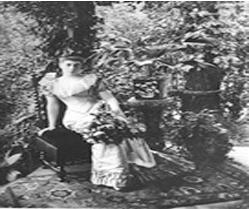
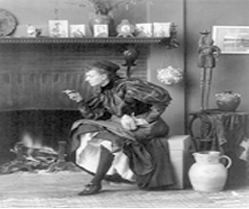
Alice Austen, Self-portrait on the veranda, ca. 1888. France Benjamin Johnston, Seated in front of fireplace, 1896.
[xiv]. To get a closer look at the visual anthropology focus, see the bibliography in this article about the following work:, SAMAIN, Etienne Ghislain (org.). O Fotográfico (1998); GEERTZ, Clifford A arte como um sistema cultural. In: O Saber Local novos ensaios em antropologia interpretativa. (1997); BARBOSA, Andréa, CUNHA, Edgar Teodoro da, HIKIJI, Rose Satiko Gitirana (orgs.) Imagem-Conhecimento Antropologia, cinema e outros diálogos (2009), BARBOSA, Andréa e CUNHA, Edgar Teodoro da. Antropologia e Imagem (2006); and SCHERER, Joanna.“Documentário fotográfico: fotografias como dado primário na pesquisa antropológica” (1996).
[xv]. My translation.
[xvi]. Pierre Bourdieu wrote this analysis about the straightforwardness in photography, with a social and symbolic bias and a more sociologic character, in the chapter “La definición social de la fotografia”, from the book La fotografia: un arte intermedio (1979). Thus, resuming what he wrote in the article “O Camponês e a Fotografia”, together with Marie-Claire Bourdieu, which was the first version of her research (2006:31,37,38) and which presented a more descriptive and initial focus. The book as well as the article were originally published in 1965.
[xvii]. We understand metalanguage as the language that talks about itself when addressing its own codes used for expression and communication.
[xviii]. Testimonial of Renata Rosenthal given to the author in 25/02/2014.
[xix]. In the greatest exhibitions she participated in – “Hildegard Rosenthal Fotografias” (MAC USP, 1974); at the “XIV Bienal”, when she received an award (1977); and the exhibition “Tradição e Ruptura”, at Pavilhão da Bienal (1984) – none of the images in this series were shown.
[xx]. The comment from Renata Rosenthal is relevant and revealing, as it shows that her grandmother dressed elegantly, but was also a simple person. Besides, it is important to highlight in this testimonial that the independent and autonomous behavior of the photographer came, partly, from her education in Germany, in the 1920s, and the fact she had been through two wars, which leads to this kind of attitude and behavior for survival.
[xxi]. Alexander Rodchenko (1891-1956) was one of the most important references of the Soviet avant-garde, of the 1930s. He is known as a photographer, sculptor, plastic artist and designer (https://www.moma.org/artists/4975?locale=pt).
[xxii]. “In every self-portrait, or almost all of them, we can find elements of interrogation and self-affirmation, an existential contradiction faced under the effect of doubt, which is inherent to all artistic activity” (My translation).
[xxiii]. According to psychoanalysis, the alter ego is understood as “the other dual imaginary link, the other image on the mirror” (LAPLANCHE and PONTALIS: 2001). In the colloquial sense, alter ego can be understood as a person’s representative, a partner or someone close who is completely trusted. For example, in a comment by Freud about the doctor and Austrian writer, Arthur Schnitzler (1862-1931), who he considered his alter ego, he said that in dealing with theoretical investigations of the human psyche, both “followed the same path’” (2006: s.p.). Regarding the alter egos of Hildegard Rosenthal, according to the explanation presented here, we notice that the appropriation of the psychoanalytical sense of the term enriches this reflection. The idea of similarity is a marking attribute in the alter ego with regard to the original person, as it allows for the manifestation of unique facets of the individual within the diversity of the subject.
[xxiv]. Taken from testimonial by Rosa Esteves, another friend of Hildegard Rosenthal, given to the author in 22/12/2014.
[xxv]. (http://www.getty.edu/art/collection/objects/46763/man-ray-rrose-selavy-marcel-duchamp-american-1923/).
[xxvi]. RAGO, Margareth. 1997. Trabalho feminino e sexualidade. In: PRIORE, Mary Del. História das Mulheres no Brasil.
[xxvii]. Idem, p. 581, 582.
[xxviii]. Remember that during this period, the photographer Alice Brill (1920-2013), also of German origin, produced her photo essays in the public space, with a look towards modern photography, in São Paulo. (DINES, 2017)

labrys,
études féministes/ estudos feministas
julho/ 2017- junho 2018 /juillet 2017-juin 2018